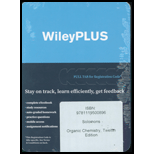
Consider the interconversion of cis-2-butene and trans-2-butene.
(a) What is the value of
(b) Assume
(c) Sketch a free-energy diagram for the reaction and label
Want to see the full answer?
Check out a sample textbook solution
Chapter 7 Solutions
ORGANIC CHEMISTRY-WILEYPLUS ACCESS PKG.
Additional Science Textbook Solutions
Chemistry: Structure and Properties (2nd Edition)
Campbell Biology (11th Edition)
Physics for Scientists and Engineers: A Strategic Approach, Vol. 1 (Chs 1-21) (4th Edition)
Applications and Investigations in Earth Science (9th Edition)
Anatomy & Physiology (6th Edition)
- Please correct answer and don't use hand ratingarrow_forwardNonearrow_forwardDraw Newman projects for each of the following molecules with 3 different rotational angles from carbon 2 to carbon 3. Rank your structures from lowest to highest energy. What causes the energy differences? Label the overlap. a. b. Br OH C. Br Brarrow_forward
- Draw the stereoisomers of 3,5-diethylcylopentane. Identify the different relationships between each molecules (diasteromers, enantiomers, meso compounds, etc.)arrow_forwardPlease correct answer and don't use hand ratingarrow_forwardPlease correct answer and don't use hand rating and don't use Ai solutionarrow_forward
- Show work....don't give Ai generated solutionarrow_forwardIs it possible to do the following reduction in one step? If so, add the necessary reagents and catalysts to the reaction arrow. If not, check the box under the drawing area. T G टे 13arrow_forwardPlease correct answer and don't use hand ratingarrow_forward
 Chemistry: The Molecular ScienceChemistryISBN:9781285199047Author:John W. Moore, Conrad L. StanitskiPublisher:Cengage Learning
Chemistry: The Molecular ScienceChemistryISBN:9781285199047Author:John W. Moore, Conrad L. StanitskiPublisher:Cengage Learning
